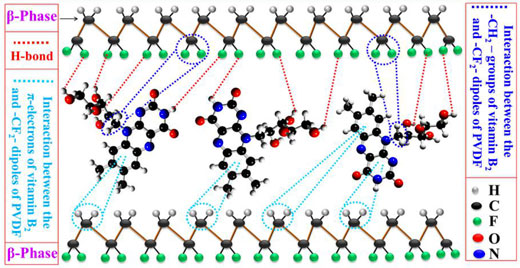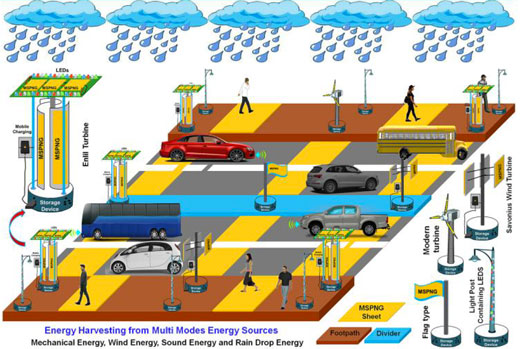| Feb 28, 2019 | |
Vitamins are good for your multi-energy nanogenerator |
|
| (Nanowerk Spotlight) The concept of piezoelectric nanogenerators is based on self-powering nanodevices and nanosystems that use the energy harvested from the environment in which these systems operate. This offers an intriguing approach for harvesting mechanical energy using organic and inorganic materials (read more: "Nanotechnology for self-powered systems"). | |
| These self-powered energy harvesters convert kinetic energy created from vibrational and mechanical sources into electrical power, removing the need of external circuits or batteries for electronic devices. | |
| Continuous energy harvesting sources are plentiful in our everyday life in various forms such as wind, waves, acoustic energy, walking, running, joint movements, kicking, rotating car tires, even heartbeat and blood flow. | |
| In order to minimize potential environmental and health issues of these energy harvesters they ideally should be made with biocompatible and biodegradable natural materials. So far though, there have been few reports on biocompatible and biodegradable biowaste-based piezoelectric materials, due to their low piezoelectric coefficient, low power and low energy conversion efficiency (in previous Nanowerk Spotlights we did however report the use of eggshell membranes and onion skin bio wastes, as well as spider silk as piezoelectric materials for these nanogenerators). | |
| In new work, reported in Nano Energy ("Designing high energy conversion efficient bio-inspired vitamin assisted single-structured based self-powered piezoelectric/ wind/ acoustic multi-energy harvester with remarkable power density"), researchers have reported a simple, innovative and inexpensive design of a vitamin-based hybrid biocompatible nanogenerator with energy harvesting ability from various energy sources in a single device. | |
| This work has been a collaborative research effort between the Indian Institute of Technology Kharagpur (IITKGP) and Pohang University of Science and Technology (POSTECH), South Korea, led by Professors Bhanu Bhusan Khatua and Jin Kon Kim, respectively. | |
| "This is the first time that inexpensive and biocompatible vitamin B2 has been used as a novel and effective β-phase stabilizer to enhance the piezoelectric performance of PVDF (a thermoplastic fluoropolymer)," Sumanta Kumar Karan, a PhD student at IITKGP and the paper's first author, tells Nanowerk. "Our device shows an enormous improvement in the output voltage (∼61.5 V) and current values (∼12.2 µA) under mechanical stress, in comparison to various reported bio/non-based piezoelectric energy harvesters. Additional remarkable performance values are instantaneous peak power density (∼6.1 mW/cm3) and outstanding energy conversion efficiency (∼62%)." | |
| "This level of power generation of a single device enables illuminating more than 100 LEDs or mobile LCD screen directly or power up a DVD drive or smart phone through charging a commercial capacitor," adds Dr. Sandip Maiti, Post-Doctoral Fellow at POSTEC. "Moreover, generation of electricity from various noises allows the device to be used as an artificial acoustic ultra-sensor. Because the device is biocompatible in nature, it could potentially be used in self-powered healthcare monitoring and biomedical systems, even in vivo." | |
| The attractiveness of using vitamin B2 is that it is biodegradable and biocompatible, thermodynamically stable, low-cost, has delocalized π-electrons, contains multiple numbers of hydroxyl groups, carbonyl groups and amino groups in its backbone. Hence, there is a high possibility of interaction between PVDF and VB2 through strong H-bonding, leading to the formation of electroactive β-phase in PVDF. | |
 |
|
| Schematic illustration of the various interactions of the β-PVDF (different dipoles) with the VB2. (Image courtesy of the authors) (click on image to enlarge) | |
| To explore the feasibility of the fabricated nanogenerator, in particular its multi-modes of energy harvesting capability, the team tested various potential applications in their lab. They found that their device | |
|
|
|
 |
|
| Schematic of futuristic applications of the multi-energy harvester. (Image courtesy of the authors) (click on image to enlarge) | |
| "From diversified experimental evidence of the energy harvesting capacity of our device, we propose a real-life practical outdoor application on a highway, where the sources of mechanical energy are the pressure from the running vehicles, wind (from nature and moving vehicles), sound, rainfall, and walking on the device," Khatua concludes. "The harvested and stored energy can be utilized to power various electronic systems, such as mobile power charging stations, LEDs, signal monitoring or sensors." | |
 By
Michael
Berger
– Michael is author of three books by the Royal Society of Chemistry:
Nano-Society: Pushing the Boundaries of Technology,
Nanotechnology: The Future is Tiny, and
Nanoengineering: The Skills and Tools Making Technology Invisible
Copyright ©
Nanowerk LLC
By
Michael
Berger
– Michael is author of three books by the Royal Society of Chemistry:
Nano-Society: Pushing the Boundaries of Technology,
Nanotechnology: The Future is Tiny, and
Nanoengineering: The Skills and Tools Making Technology Invisible
Copyright ©
Nanowerk LLC
|
|
|
Become a Spotlight guest author! Join our large and growing group of guest contributors. Have you just published a scientific paper or have other exciting developments to share with the nanotechnology community? Here is how to publish on nanowerk.com. |
|
